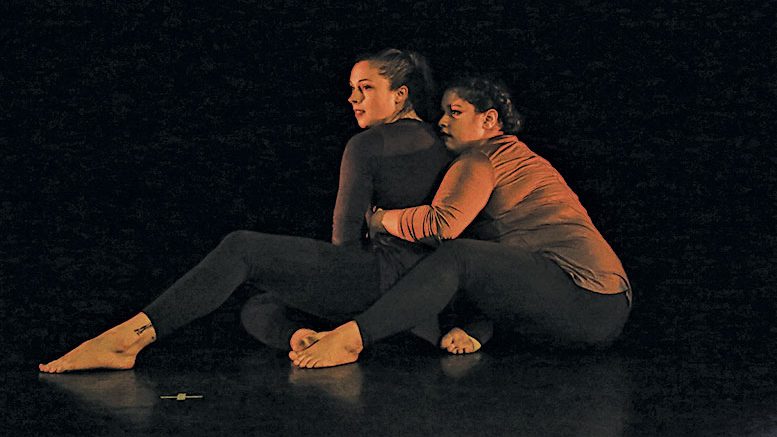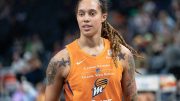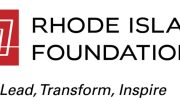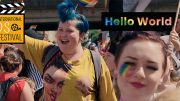…that’s what she said explores feminine experience, gender, identity, love and rage, premieres in Boston on March 12-15
BOSTON—Societal resistance to gender equality comes center stage in …that’s what she said, a dance production exposing intersectional societal narratives from the feminine experience, including those who are also a part of the LGBTQ+ community, according to the show’s creative director.
“In bringing together a diverse group of femme-identifying choreographers, the production showcases the dynamic range of the feminine experience,” said Kristin Wagner, Creative Director of Lady BOS Productions and member of the …that’s what she said choreographer cohort. “So much of the narrative of both history and the present is controlled by those with the most privileges. I wanted to create a platform for more perspectives in an effort to challenge, or at least diversify or expand, our usual societal narrative.”
In …that’s what she said, part of that “dynamic range” includes artistic works from creative and life partners that are currently researching heteronormativity and public versus private displays of affection.
Angelina Benitez and Rebecca Lang, members of the …that’s what she said choreographer cohort, explore their unfiltered relationship, not only through movement but by a soundscape of intimate, candid and private conversations the couple have experienced in their home.
“In the process of creating this piece, we became fixated on what our sound should be,” said Benitez. “We considered silence among other things but when we turned to the other women in our cohort for advice, one of them suggested the idea of recording the sounds of our home. I took this one step further and started to record us—without Becca’s knowledge. The recordings are candid but have been edited so everything is jumbled. We felt that this would add a layer of vulnerability and context. We wanted to expose things we actually say to each other; the different tonalities, vocabulary, and content that is usually filtered.”
Wagner, also an ally of the LGBTQ+, applauds the work of the women and relates the conversations exposed to her own relationship experiences.
“I absolutely love this element of the work,” said Wagner. “As a witness to the work. I can only make out bits and pieces of the actual conversations. When I do pick up on the specifics, the content ranges from comical to intimate, which feels so relatable to my own experiences in relationships. It adds a layer of authenticity that is not always present in dance theater.”
When others come first
In a scenario all too familiar to same-sex and/or queer partners, relationships are often muted or downplayed in an effort to make others around the couple feel comfortable.
“I feel a constant need to create more space between us in order to make other people feel comfortable,” said Lang. “This comes from a place of internalized homophobia as well as a response to external homophobia.”
According to Benitez, the couple is constantly aware of the reactions and subsequent treatment from others.
“It’s a constant challenge to stay genuine,” she said. “I’ve caught myself letting go of Becca’s hand to refrain from being judged. We’re always aware of other people’s reactions.”
Familial expectations and assumptions can be at the epicenter of the adversity and consequential impact of heteronormativity.
“I think the largest way heteronormativity has impacted us as a couple was when my parents assumed that I would be straight,” added Benitez, who is also a member of the Latinx community. “I was closeted to most of my family when I started dating Becca. I wanted so badly to introduce her to them as my significant other and have it be ‘normal.’ The entire process of coming out to my parents was physically and emotionally tolling but I’m grateful for the counseling and support I received from my community. Thankfully, my parents have since expanded their views and are very supportive of our relationship.”
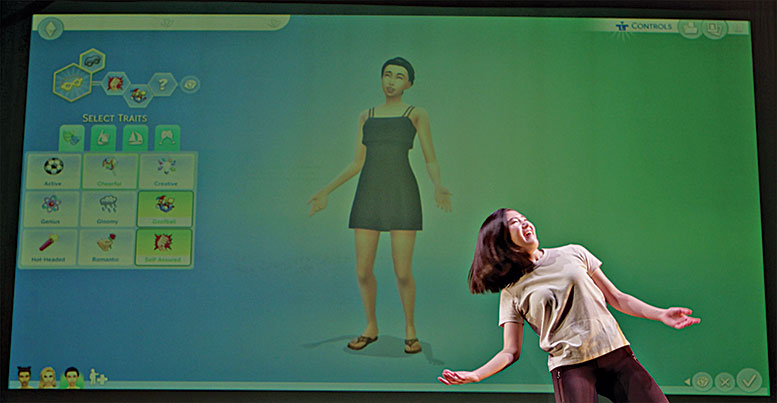
Olivia Blaisdell captured via a video still shot mid-performance; Photo: David Orr, Boston Moving Arts Productions
Olivia Blaisdell, a biracial student, exposes the damaging effects that labels can place on young people, using her intrigue of computer game avatars to explore identity.
“I have struggled most of my life with labels and how I should act with those assigned labels,” she explained. “I believe assigning myself labels in the first place was definitely a result of growing up female. My mother always read me those books specifically for the development of a teenage girl as if I was supposed to resemble the cookie-cutter figure in the book.”
Blaisdell’s work uses The Sims as a catalyst to express identity through projection and dance.
“In my piece, I focus on identity. I use the Sims video game to build metaphorical societal constructs, and throughout the piece you see my dancers try to break out of this mold,” she said. “I think it’s a comment on my personal experience, but I think [it’s] an experience that everyone has at some point in their lives.”
The impact of oppression
“As a social worker, I’ve been trying to understand the way privilege and oppression affect different identities,” Lang said. “I feel safe day-to-day within the supportive Salem community. I’m able to feel supported emotionally and financially by the people I love. So many parts of myself allow me to experience privilege compared to other people. I’m really lucky, but people are still ignorant.”
Benitez said that tokenism often comes to the forefront of the struggles she’s experienced and ultimately how those struggles have hindered her experience to be authentic at the time.
“I’m Mexican but was raised in a primarily white town,” Benitez said. “I could count on one hand how many other Latinx people were in the entire student population. At times, I was so proud and also so embarrassed of being ‘the Mexican.’ I didn’t understand it at the time, but teachers tokenized me. They had the best intentions, but it was inappropriate. My biracial experiences definitely influenced my understanding of my sexuality. I constantly felt like I wasn’t Mexican enough or white enough—why would I want to debate feeling queer enough? Why would I want to identify with another marginalized group?”
Microaggressions
Microaggressions says psychologist Derald Wing Sue, author of the book “Microaggressions in Everyday Life”, are deemed as the “everyday slights, indignities, put-downs and insults that people of color, women, LGBT populations or those who are marginalized experience in their day-to-day interactions with people.”
Wing Sue, also professor of psychology at Columbia University’s graduate school of education, explained in an interview given to the Globe and Mail (2016), that in his day-to-day interactions with people, “they would say things or do things that appeared to be compliments but that left me feeling insulted, invalidated and hurt.”
“One example I like to give to people is that I’m often complimented for speaking good English. [He was born in the U.S.],” he told the publication. “To the person saying it, it’s perceived as a compliment, but it happens to me so often, as an Asian-American, that the underlying, hidden message is that ‘You are not a true American. You are a perpetual alien in your own country.’”
Lang, on the other hand, doesn’t believe in microaggressions and instead classifies all aggressions as a form of hate.
“I think all aggressions are targeted and come from a place of hate,” Lang said. “I was in [a local coffee shop] … and overheard ‘what are real families made of—a woman, a man, and kids.’ If me and Angie ever want to have a family, I fear that it wouldn’t be legitimized the way heterosexual relationships would [be]. There’s a real need for society to approach identity as learners. Mistakes happen—but we need to learn from them. The danger zone is when you think you understand everything.”
Intersectionalities
Benitez described the toll it takes on her to live authentically due to society’s acceptance of various identities and still strives to understand others who differ from her as well.
“Being a queer, biracial woman in my environment made me feel like I had to constantly be fighting and standing out,” said Benitez. “When I was younger, this meant hating pink—even if I liked it, being a great ‘ally’ in the Gay-Straight Alliance, and making my [online] username ‘mexitalian292.’ My techniques for fighting the patriarchy have since developed, but it still remains exhausting. While fighting for the identities I know—I try my best to learn about other identities and keep an open mind.”
As for Blaisdell, she is working on defying the labels imposed by society of her intersectional identities, which at times are at odds with each other.
“I often joke that I am a triple minority,” she said. “In the past, I have also viewed being a woman, being queer, and being biracial as separate categories because, ironically, these minority groups tend to discriminate toward each other. Seeing myself this way spread me thin, but now I try to break down the walls that tell me that I need labels. I try to be confident about these characteristics that make me unique. Then again, it is difficult seeing women who claim to be fighting for ‘women’ and do not see beyond the scope of the ‘straight, cis, white female.’”
The importance of the feminine experience
Social media and the current political climate have reignited contentious conversations, that tie directly into patriarchy and silencing women’s voices.
“The current political climate is composed of representatives with patriarchal standards,” said Lang. “It’s reflected in women’s access to reproductive health, leadership roles, and so much more. Even in female-dominated fields, men are dominating leadership roles. When women are in roles of leadership, they are so easily criticized for their effect.”
Benitez agrees and believes through example, children can dismantle oppression.
“I feel it’s necessary to set an example for the next generation,” Benitez added. “I don’t want my family or the children I teach to grow up with the patriarchal ideas that we did. When I look at my 3-year-old niece, I don’t want her to feel limited or pressured to conform to ideas associated with gender. We need to focus on uplifting women—and trans and non-binary folks for that matter—so children know that oppressive behavior is unacceptable.”
Disproportionate representation
Despite the fact that women outnumber men in the dancing sphere, Wagner noted the disproportionate numbers of female representation in highly acclaimed choreographed works.
“Many people outside the dance world would probably assume that women in dance are women in power, simply because we far outnumber men,” Wagner said. “This is simply not true. While women do make up a majority of the dance population, there is a distinct lack of women thriving in the upper tiers of leadership and production in the field of dance at large.”
“A few years ago, the New York Times published an interview with three leading ballet choreographers, all of whom were men,” she recalled. “The interviewer asked the men their thoughts on the significantly lower percentage of female choreographers who make it to the level that they were currently operating at. Two of the choreographers dismissed the question as irrelevant, and Justin Peck said, ‘There needs to be more encouragement and support for women—at an impressionable age—to explore that choreographic side of their brains.’”
The need for “more encouragement,” however, isn’t how Wagner would explain it.
“Within the dance world, it seems men either don’t notice this or, as Peck did, assume that the problem is that women are not encouraged to choreograph,” Wagner said. “There are so many female choreographers in Boston, in the United States, and around the globe producing incredible work, yet still—most major producing theaters are presenting works created by men and most major dance companies are hiring male choreographers.”
Looking at the big picture, Wagner said her focus is to advance the voices of women in dance as a whole.
“I like to say my curatorial practice, particularly with this production, is based on people, not product. I engage artists who are curious, who are open to development and growth within their artistic practice, and who are committed to producing engaging, high-caliber, thought-provoking work,” she said. “In focusing on the needs of these artists—by supporting them in their development process through peer review sessions, by supporting them in the promotion of their work through access to quality media documentation, and by supporting them in the continuation of their work through grant writing consultations—I hope to elevate the position of women in dance, to increase the presence of female choreographers in the contemporary dance community, and to amplify the feminine voice and experience. If this show leads to any sort of career advancement for even just one of the choreographers involved, I will consider it a success.”
Masculinity
Although the show empowers women to present their choreographed work, Wagner notes that not all pieces are from the female experience—some are focused on masculinity.
“For example, my work is specifically about masculinity, as explored from my perspective as a female,” Wagner said. “The idea of showcasing dances ‘from the feminine experience’ was to allow femme folks to explore and present whatever work is interesting to them from their unique point of view. The dances are from the feminine perspective rather than strictly about the feminine experience.”
Deconstructing the system
Benitez is determined to deconstruct systems of oppression commonly experienced by LGBTQ+ people.
“My goal for us was to be shamelessly authentic. I want for people to be able to relate to the content of our piece, queer or otherwise,” she said. “I want to bring our queerness to the forefront and dismantle heteronormativity one performance at a time.”
Through their work, Lang seeks to expand her vulnerability.
“With this show, I want to allow myself to be more vulnerable in a performance by exploring this subject that is so personal and individual,” she said. “I’m excited to see how the audience responds to the work, especially in the Q&A.”
Blaisdell hopes the production serves as a catalyst for an honest exchange of ideas.
“I hope this show opens up conversations over dinner & drinks,” she said. “I hope [it] sparks curiosity, anger, sadness, and allows individuals to bring their own personal experiences to whatever meaning they assign each piece.”
And according to Wagner, themes range from identity, gender and love to the depiction of female rage and male aggression.
“The vocabulary of the works parallel one another—anger is universal—and I hope the inclusion of both within the same show provokes some thought regarding the performance of gender and its effect on our ability to express emotion freely and be fully ourselves,” Wagner said. “ … For me, it is not a matter of focusing specifically on women and the feminine experience right now—it is a matter of offering more opportunities for women in dance to create, to present, and to advance their careers. I can’t tackle the country or the globe, but I had an opportunity to create space within my local community, so I did.”
… that’s what she said runs from March 12-15 at the South End / Calderwood Pavilion at the BCA in Boston. For more information, to attend an exclusive workshop or to purchase tickets, check out https://bit.ly/2Tg99rd.

